RapidX
The Regional Rapid Transit System (RRTS), operating under the brand name Namo Bharat,[1][2] is an elevated rapid rail[3][4][5][6][7] system operated by the National Capital Region Transport Corporation (NCRTC) in India's National Capital Region (NCR). The goal of the Namo Bharat is to replace the conventional non-air-conditioned MEMU-operated local train network with an elevated rapid rail system,[8] which will be first-of-it's kind of rapid rail in the world[9] The semi-high speed trainsets which are providing services on Namo Bharat have been specifically named as Namo Bharat only, having average speed of 100km/hr.[10]
| RapidX | |
|---|---|
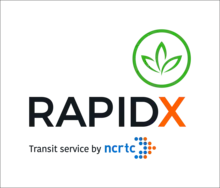 | |
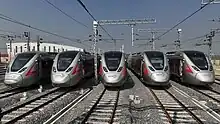 Namo Bharat Trainsets | |
| Overview | |
| Service type | elevated rapid rail |
| Status | Partially operational |
| First service | 21 October 2023 |
| Website | ncrtc |
| Route | |
| Line(s) used | 8 (planned) 1 (partially commissioned) |
| On-board services | |
| Class(es) | Economy class Business class Women's class |
| Seating arrangements |
|
| Observation facilities | Large windows for panoramic view |
| Entertainment facilities | |
| Baggage facilities | Overhead racks |
| Other facilities |
|
| Technical | |
| Rolling stock | Namo Bharat EMUs |
| Track gauge | 1,435 mm (4 ft 8+1⁄2 in) standard gauge |
| Electrification | 25 kV 50 Hz AC Overhead line |
| Operating speed | 160–180 km/h (100–110 mph) 100 km/h (60 mph) (Average speed) |
| Average length | 384 metres (1,260 ft) (16 coaches)
192 metres (630 ft) (8 coaches) |
| Rake maintenance | Duhai Depot, Duhai, Uttar Pradesh |
Germany’s Deutsche Bahn will operate and maintain the entire Delhi-Ghaziabad-Meerut rapid rail transit corridor after winning bid value at estimated price of Rs 1500 crores for 12 years. [11]
History
The plan for a regional rapid transit service to connect Delhi with nearby towns was proposed in the late 1990s by Indian Railways. In 2006, When the Delhi Metro was expanding, the plan was under consideration as a part of Delhi Metro's expansion to nearby lying towns.[12] The government later formed National Capital Region Transport Corporation (NCRTC) in 2013 to take up the implementation of eight planned Regional Rapid Transit Systems (RRTS) that would decongest Delhi within the 100–200 km radius of the region.[8][13][14]
In October NCRTC branded RRTS services is inaugurated as Namo Bharat[15] and the trainsets as Namo Bharat trainsets in October 2023[16].
Features
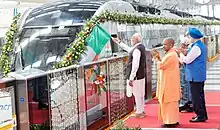
Integration
To provide commuters with convenient, seamless travel experiences, the three phase-1 Namo Bharat corridors, Delhi – Ghaziabad – Meerut; Delhi – Panipat; and Delhi – Gurugram – SNB – Alwar, will converge at Delhi's Sarai Kale Khan and will be interoperable, in the sense that trains will be able to move from one corridor to another. This will facilitate commuter travel from one corridor station to another without requiring train changes, thus enabling commuters to leave their private vehicles and switch to the Namo Bharat.[17][18]
Namo Bharat stations will be integrated wherever possible with other modes of public transport, such as airports, Indian Railway stations, inter-state bus terminals, and Delhi Metro stations. Such integration will facilitate seamless commuter transfers from one mode of public transportation to another, thereby encouraging the use of public transport systems. While the Namo Bharat will act as a backbone for regional transportation, Delhi Metro lines will complement the Namo Bharat by acting as feeder lines. The Sarai Kale Khan Namo Bharat station will be a mega-terminal where all three Phase-I Namo Bharat corridors will merge.[17][18]
| Namo Bharat stations | Integration |
|---|---|
| Ghaziabad | New Bus Adda |
| New Ashok Nagar | New Ashok Nagar metro station |
| Anand Vihar | Anand Vihar metro station, Anand Vihar ISBT, UPSRTC bus depot (Kaushambi), and Anand Vihar Terminal railway station[19] |
| Sarai Kale Khan | Sarai Kale Khan – Nizamuddin metro station, Hazrat Nizamuddin railway station, and ISBT Sarai Kale Khan |
| INA | Dilli Haat – INA metro station |
| Aerocity | Indira Gandhi International Airport and IGI Airport metro station |
| Udyog Vihar | Proposed extension of Rapid Metro Gurgaon |
| Kherki Dhaula toll | Proposed Bawal Metro and proposed bus terminus |
| Panchgao | Proposed Bawal Metro, proposed ISBT, and proposed multimodal hub |
| Bawal | Bawal bus stand |
Ticketing
- Digital QR code-based Ticket – The commuter can purchase the ticket using RapidX Connect mobile application.
- National Common Mobility Card (NCMC) Card – The passengers can travel with any NCMC compliant card. One can purchase these cards from the ticket counter at the stations. This card can be recharged with a minimum value of Rs 100 up to a maximum value of Rs 2000.
- Ticket Vending Machine (TVMs) – The TVMs cards are equipped with a credit/debit/prepaid card reader compliant with RuPay/Master/VISA standard for non-cash payment transactions in addition to Cash mode of Payment. The NCRTC has installed 4 TVMs each at Sahibabad and Ghaziabad and 2 TVMs each at Guldhar, Duhai and Duhai Depot.
- Paper QR code-based journey ticket – One can generate this ticket via TVMs or bought from Ticket Counters at the stations.[20]
Facilities
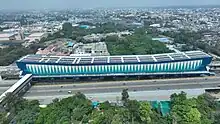
Business class: Each Namo Bharat train will have a separate business coach. This will encourage business class commuters to switch to public transport for intercity travel.
Comfortable travel: The air-conditioned Namo Bharat coaches will have transverse seating arrangements with overhead luggage space and Wi-Fi connections, among other modern amenities.
Women's coach: Each Namo Bharat train will have a separate coach for women travellers, just like the Delhi Metro.
Universal accessibility: The entire infrastructure of the Namo Bharat, including stations and trains, will be designed with universal accessibility in mind.
Wireless Railway Signaling System
Nokia partnered with Alstom to implement the 4.9G/LTE private wireless network to support the ETCS L2 signalling in Regional Rapid Transit System. This is a “world-first application” of an LTE network that is being used along with ETCS Level 2 signaling to provide high-speed, high-reliability commuter service. In addition, ETCS Level 2-based system allows trains to report their precise location in real-time.[21]
Cargo handling
In order to maximize the utilization of the Namo Bharat system, the routes will also be used for moving cargo during non-peak hours. Goods such as perishable ones are expected to avail benefits from the service. It is expected to reduce the pollution footprint after decongesting the road between the two cities by taking out trucks. The trainset depots of the system are set to be equipped with warehouses and other cargo handling facilities.[22]
Technology
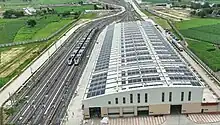
The NCRTC is implementing a state-of-the-art rail-based rapid transit system in the NCR with a design speed of 180 km/h. Such a design speed will necessarily require the installation of grade-separated tracks and the latest signalling and control systems to ensure high throughput and safe operation. The rolling stock (train cars) will be air-conditioned and capable of fast acceleration and deceleration in a very short time span. Traction power will be delivered through a uniquely designed 25 kV flexible overhead catenary traction system for elevated stations and a rigid overhead catenary system for tunnels.
Rolling stock
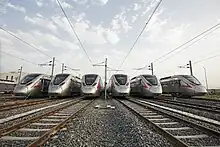
The trains for the service were specially developed for a fast and comfortable regional commute. The lightweight stainless steel body of the Namo Bharat (trainset) train with aerodynamic nose allows for reducing air drag at higher speeds (180 km/h). The train was designed in Alstom's engineering centre in Hyderabad and was manufactured by Bombardier Transportation in Savli.[23]
Ballastless track
A Slab Track Austria system, recognized for providing excellent riding comfort even at high speeds of 180 km/h. These tracks are being used in India for the first time. The tracks are also preferred for their longer life span, reduced maintenance requirements, and ease of replacement.[24]
ETCS Level 2 signalling system
The ETCS Level-2 signalling system is used globally for high-speed railway transit. The system is equipped with modern signalling with virtual blocks & ATO functionality over an LTE backbone and is being used for the first time in India. A key feature of the RRTS is the interoperability of all the corridors, and ETCS Level-2 makes this possible. The system can monitor train speed and direction and provide operational directives using a radio block centre. Use of a virtual block facilitated by ETCS Level-2 signalling eliminates any possibility of train collision.[25]
SPEED – Systematic Program Evaluation for Efficient Delivery of Project
SPEED is NCRTC's in-house, sophisticated, robust, reliable, and user-friendly monitoring and project management platform for reporting activities of the pre-construction and construction phases of the RRTS. SPEED leverages technological infrastructure frameworks such as JavaScript, PHP, etc.
Common Data Environment (CDE)
A CDE is implemented to maintain a common repository for all construction and pre-construction drawings and technical documents. It enables collaboration and sharing of updated information, documents, and drawings in real-time to achieve a single source of truth across an organization, manage the design, define and implement workflows, and monitor progress actions across the organization.[26][27]
Building Information Modelling (BIM)
BIM is an intelligent 3D model-based process that gives architecture, engineering, and construction professionals the insight and tools to effectively plan, design, construct, and manage buildings, infrastructure, and outdoor structures and elements. Project-related components like walls, doors, etc., are modelled in 3D using various BIM software. BIM offers a realistic 3D model, giving a true sense of how the actual structure will look. All the RRTS stations are currently being designed and developed using a BIM platform.[28]
Continuously Operating Reference Stations (CORS)
A CORS network system, including its control station, is being installed by the NCRTC to increase geolocation accuracy in the civil construction survey work. This system provides real-time, precise coordinates for measured locations and is capable of ensuring 5 – 10 mm accuracy in the geolocation of points, whereas regular GPS can only provide location accuracy of up to 10 to 15 metres. This eliminates cumulative errors in civil construction and results in better alignment, acting as a life cycle management solution for the project.
Network

Summary
The Delhi Meerut section of RRTS is delayed by many months. The target opening date was June 2023, but it finally opened on 20th October 2023.
Operational
Approved
Proposed
| Route | Locale | Length | Construction began | Opening | Notes |
|---|---|---|---|---|---|
| Delhi–Meerut | Delhi and Uttar Pradesh | 82 km (51 mi) | January 2019 | 20 October 2023 | Fully operational by 2025.[29] |
| Delhi–Alwar | Delhi, Haryana and Rajasthan | 164 km (102 mi) | TBD 2023 | 2025 | Pre-construction works are underway.[30] |
| Delhi–Panipat | Delhi and Haryana | 103 km (64 mi) | TBD | 2025 | Detailed Project Report (DPR) awaiting approval.[31] |
| Hyderabad–Warangal | Telangana | TBD | TBD | TBD | Proposed[32] |
| Hyderabad–Vijayawada | Telangana and Andhra Pradesh | TBD | TBD | TBD | Proposed[32] |
| Vijaywada–Amaravati–Guntur–Tenali | Andhra Pradesh | TBD | TBD | TBD | Proposed[33] |
See also
References
- "PM Modi flags off 'Namo Bharat', India's first regional rapid rail service; all you need to know". Business Today. 2023-10-20. Retrieved 2023-10-23.
- Bureau, The Hindu (2023-10-20). "PM Modi flags off country's first Namo Bharat train". The Hindu. ISSN 0971-751X. Retrieved 2023-10-21.
- https://www.timesnownews.com/india/why-rapid-rail-is-pm-modis-masterstroke-and-a-must-for-delhi-ncr-article-104627159
- https://timesofindia.indiatimes.com/city/delhi/why-rapid-rail-is-right-fit-as-delhi-ncr-gets-bigger/articleshow/104619906.cms
- https://www.indiatoday.in/india/story/delhi-noida-ghaziabad-residents-demand-connectivity-to-rrts-2452856-2023-10-24
- https://www.dnaindia.com/hindi/web-stories/viral/rapid-rail-stations-for-noida-delhi-ghaziabad-meerut-rapidx-namo-bharat-train-updates-1698155588366
- https://www.moneycontrol.com/news/business/real-estate/rapid-rail-inauguration-may-boost-property-prices-along-route-in-ghaziabad-11566181.html
- "Overview – NCRTC". Retrieved 2023-05-29.
- "'Namo Bharat' RRTS trains to be ingaurated today, service from tomorrow". OnManorama. Retrieved 2023-10-22.
- https://www.thehindu.com/news/national/namo-bharat-no-limit-to-his-self-obsession-congress-targets-pm-modi-over-naming-of-rrts-trains/article67441425.ece
- Mishra, Twesh (2022-07-01). "Germany's Deutsche Bahn wins bid to operate and maintain Delhi-Ghaziabad-Meerut rapid rail". The Economic Times. ISSN 0013-0389. Retrieved 2023-10-22.
- "Regional Plan 2021 by National Capital Region Planning Board (NCRPB)". NCRPB (PDF). 17 September 2005.
- Sethi, Neha (2013-08-01). "Centre, states set up company to build rapid transit system for NCR". mint. Retrieved 2023-05-29.
- "Fast Trains to NCR Towns under RRTS". Latest News on NCR-Delhi Realty & Infra Projects. 2010-11-17. Retrieved 2023-05-29.
- "PM Modi flags off 'Namo Bharat', India's first regional rapid rail service; all you need to know". Business Today. 2023-10-20. Retrieved 2023-10-23.
- PTI (2023-10-20). "New RRTS trains to be known as 'NaMo Bharat'". The Hindu. ISSN 0971-751X. Retrieved 2023-10-22.
Trains of the Regional Rapid Transit System (RRTS), to be inaugurated by Prime Minister Narendra Modi on Friday, will be known as 'NaMo Bharat', Union Minister Hardeep Singh Puri announced on Thursday.
- "All RRTS corridors will be interoperable: NCRTC". Business Standard India. Press Trust of India. 24 August 2019. Retrieved 2 June 2020.
- "Great move! India's 1st rapid rail corridors in Delhi to be linked to Delhi Metro, Indian Railways stations". The Financial Express. 18 June 2019. Retrieved 2 June 2020.
- "UPSRTC". www.upsrtc.com. Retrieved 25 May 2020.
- https://www.financialexpress.com/business/railways-delhi-ghaziabad-meerut-rrts-corridor-unveiling-the-fare-structure-timings-luggage-size-and-more-on-rapidx-service-3277059/
- https://telecom.economictimes.indiatimes.com/amp/news/nokia-tests-mission-critical-voice-and-data-on-4-9g-private-wireless-network-for-ncrtc/93341322
- "Cargo to move at 180kmph on RAPIDX in non-peak hours". Times Of India. 29 May 2023.
- "Delhi-Meerut RRTS: Made in India trainset handed over for Phase 1 project". Financialexpress. 2022-05-08. Retrieved 2023-05-29.
- "NCRTC to engage Ballastless Track Structure System Provider for RRTS". Urban Transport News. 13 August 2019. Retrieved 24 June 2020.
- "NCRTC to use hi-tech signalling for Delhi-Ghaziabad-Meerut section". www.outlookindia.com/. Retrieved 24 June 2020.
- "ISO". www.iso.org. Retrieved 2023-02-28.
- "NCRTC Rolls Out Wrench SmartProject as Their Common Data Environment in Record Time". Business Standard India. Press Trust of India. 17 October 2019. Retrieved 27 June 2020.
- "Delegates from Asian Development Bank visits Delhi-Meerut RRTS project". Urban Transport News. 29 August 2019. Retrieved 27 June 2020.
- "Ghaziabad: Four RRTS stations on 17km priority line to be ready by mid-March". Hindustan Times. 2023-02-25. Retrieved 2023-05-29.
- "Pre-construction work begins on Delhi-Gurugram-SNB RRTS corridor". The Hindu. 2022-05-12. ISSN 0971-751X. Retrieved 2022-05-13.
- "Haryana RRTS projects not sanctioned by centre, says Union minister". Hindustan Times. 2023-03-14. Retrieved 2023-05-29.
- "Telangana to take up Regional Rapid Transit System". The New Indian Express. 18 February 2022.
- "Metro rail projects in Vijayawada and Vizag make little headway". The Hindu. 13 March 2022.